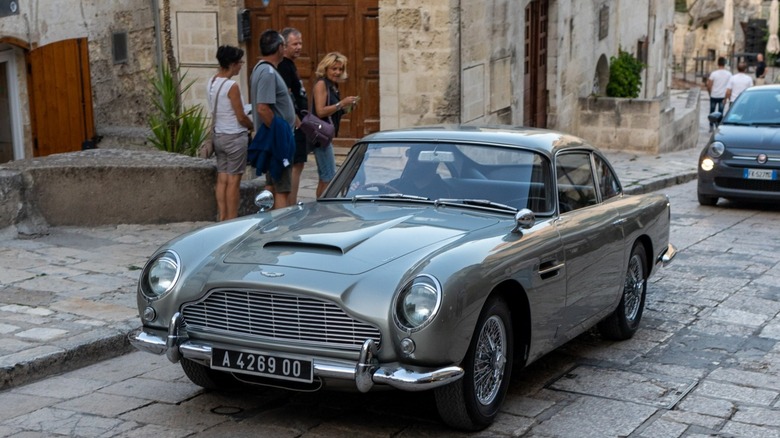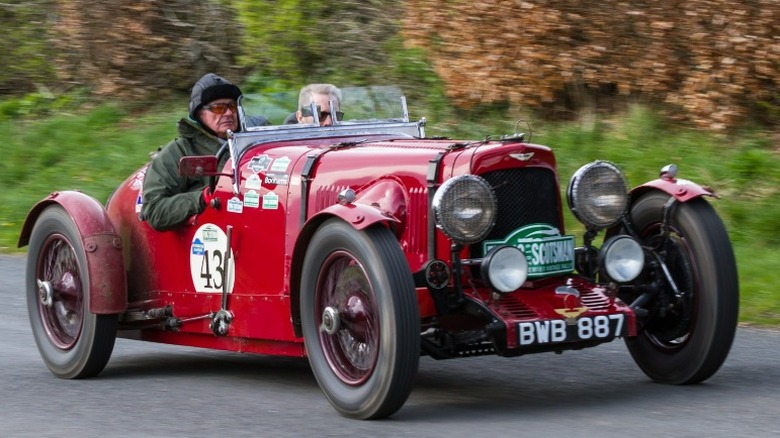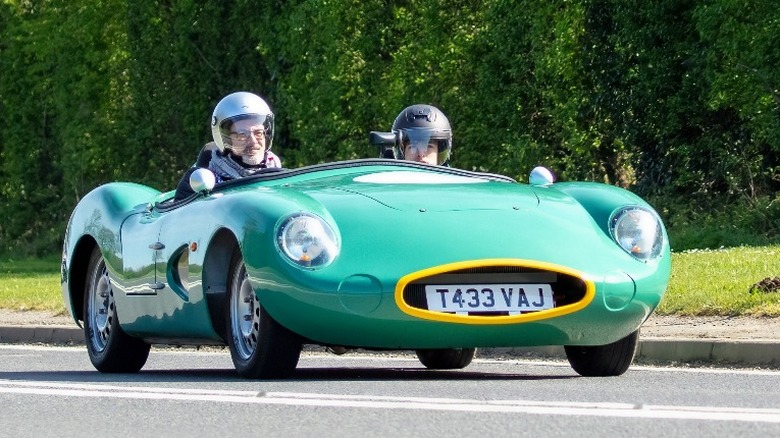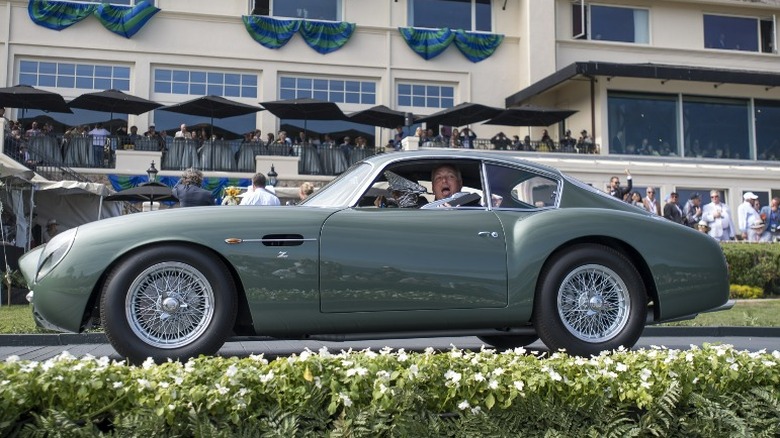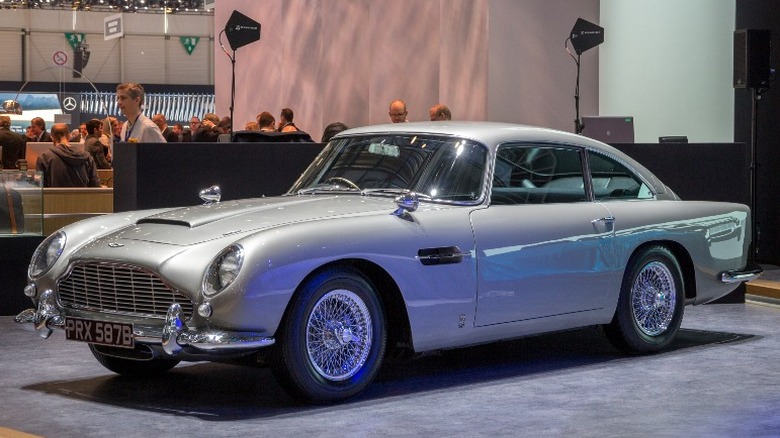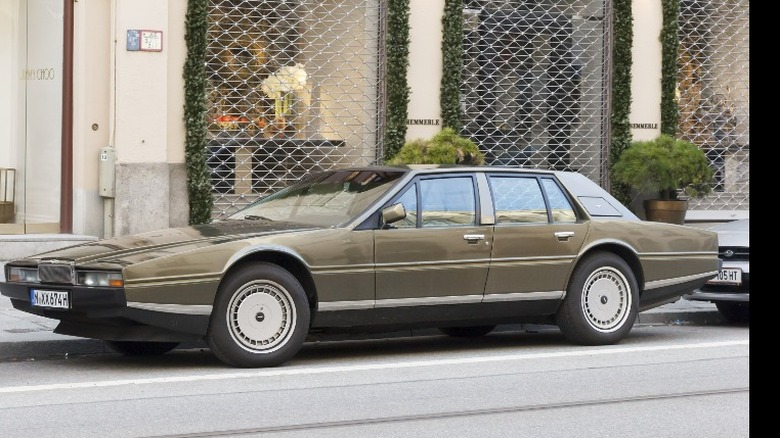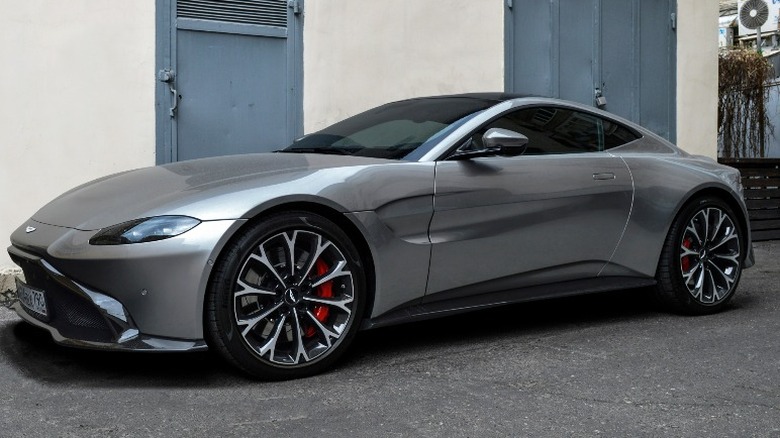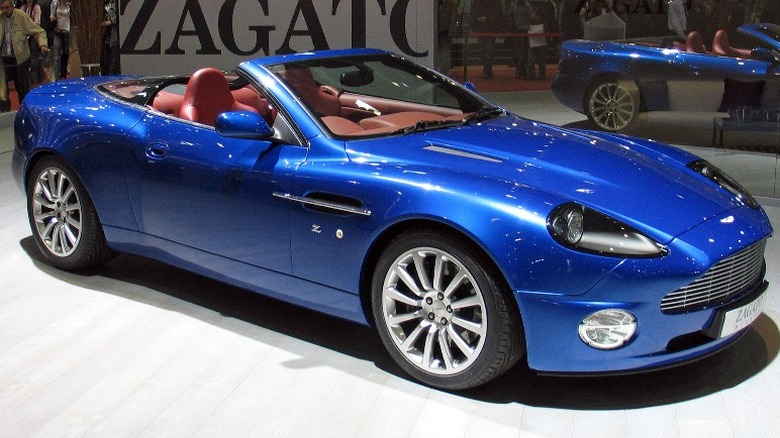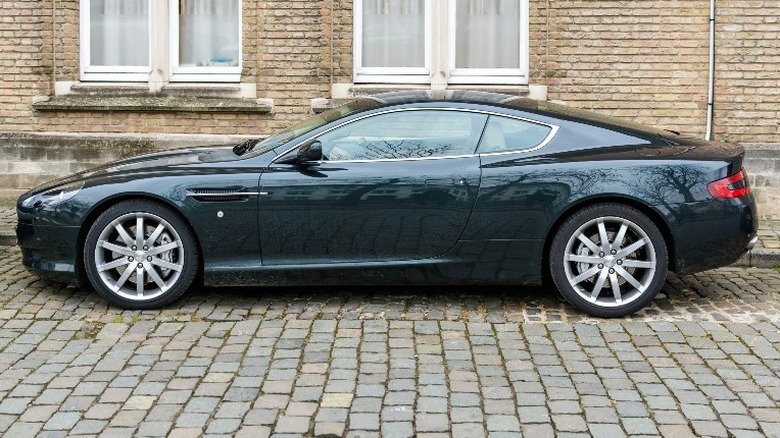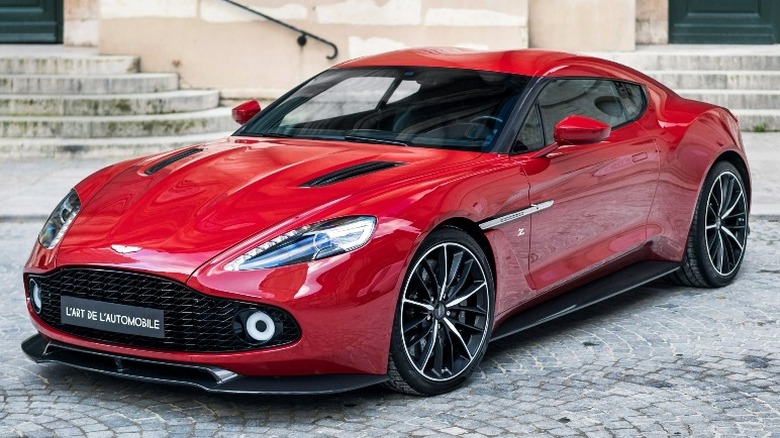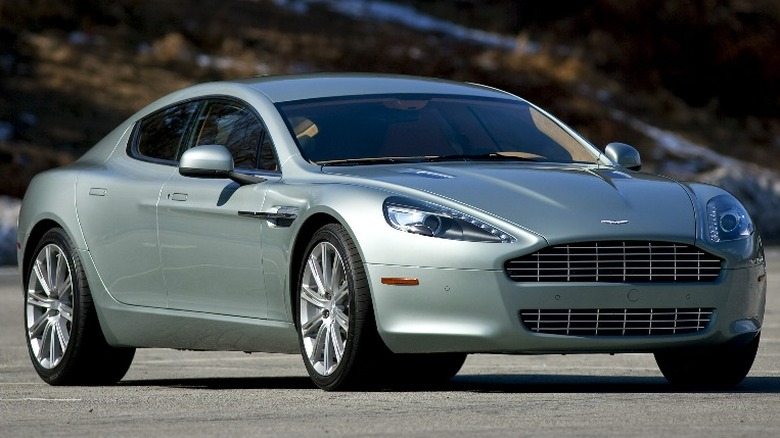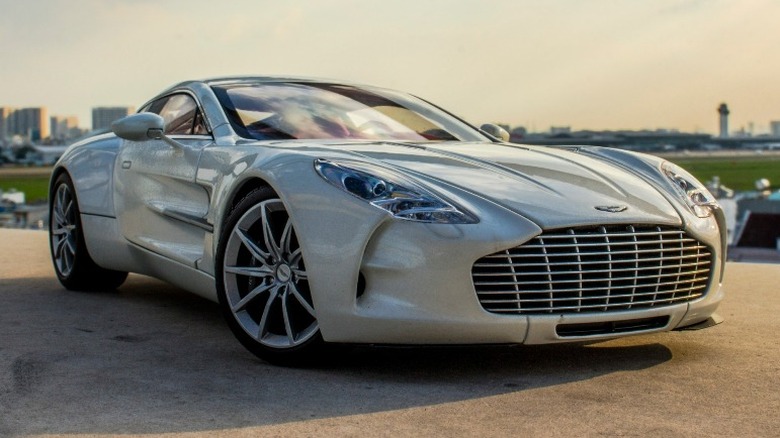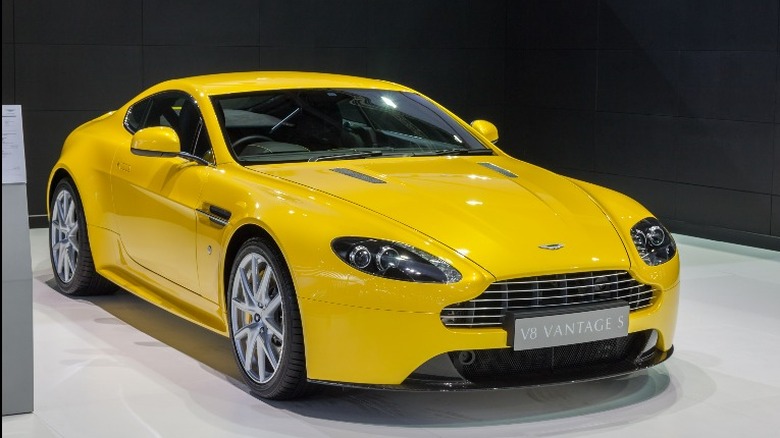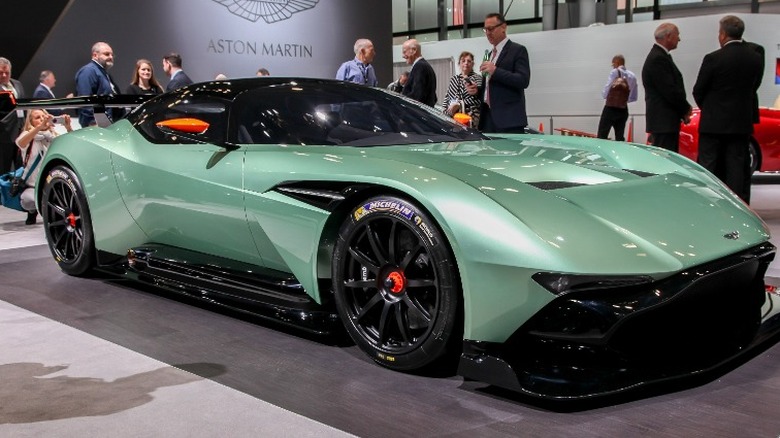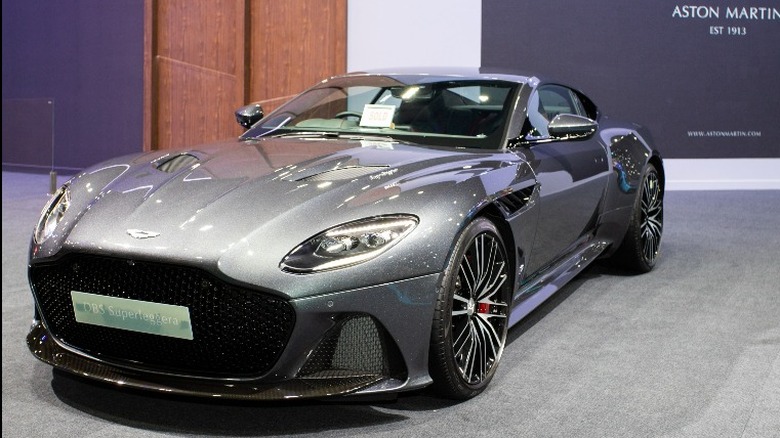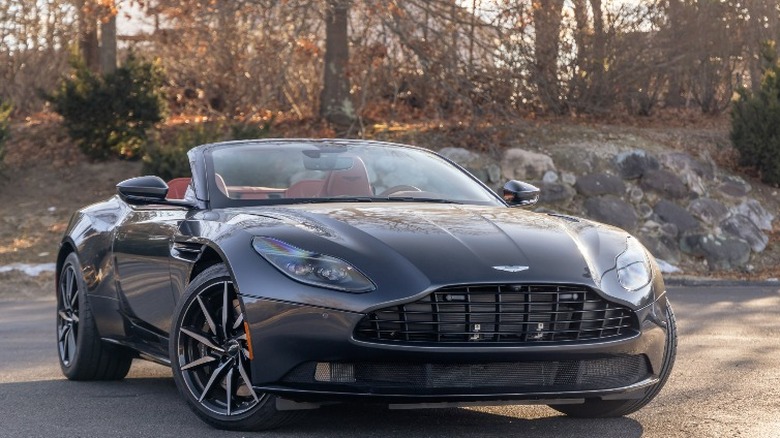The 15 Best Aston Martins Of All Time
Aston Martin has consistently offered a mixture of sophisticated luxury and exhilarating performance throughout its long history. While Italy is often considered the leader in producing high-performance sports cars such as Ferrari, Lamborghini, Alfa Romeo, Maserati, and Pagani, the United Kingdom is perhaps a close second with Jaguar, Lotus, McLaren, TVR, and the country's best-known brand, Aston Martin.
While Aston Martin's legendary reputation can be attributed to the quality of its cars, without a doubt, much of the brand's appeal comes from its association with James Bond. The 007 films became the biggest blockbuster movie franchise of the 1960s, producing a vast pop-culture sensation that featured Sean Connery as the suave secret agent who portrayed the ultimate in taste and style for the time. Whatever car he (or, more accurately, the British Secret Intelligence Service) chose to drive naturally reflected the same high-class characteristics. The 1964 Aston Martin DB5, selected for the movie "Goldfinger," became an icon, had a substantial impact on the company's direction, and, even today, still influences Aston Martin's design priorities.
Despite the help of Hollywood, the Aston Martin brand has had a troubled run over its more than 100-year lifespan. While competitors Ferrari and Porsche have experienced a relatively stable history, Aston Martin has been on the verge of bankruptcy at least once in every decade and yielded to frequent ownership changes. Nevertheless, Aston Martin has succeeded in producing remarkable sportscars with mind-blowing performance and classy style that rivals the best supercars in the world.
Aston Martin Ulster
Although the racing version of the Aston Martin Ulster only competed for a brief two years, the open-cockpit race car, powered by an A. C. Bertelli-designed 1.5-liter engine, dominated the British Tourist Trophy at Goodwood. In 1934, Ulsters took first, second, and third place, and the following year the Chassis LM20 finished third overall and first in the 1101cc to 1500cc class.
Aston Martin fitted the Ulster with a four-cylinder 1.5-liter engine that used a stepped head, domed pistons, and a single overhead camshaft to produce 85 horsepower at 5,250 rpm. A Bord & Beck single-plate clutch activated a four-speed gearbox transmission, and the cable-operated mechanical brakes provided the stopping power.
The 8-foot, 7 inches long chassis and suspension with semi-elliptical springs supported a narrow, lightweight aluminum body. The two-seater featured an outside exhaust running down the length of the car, fold-flat windscreens, and a horizontally mounted spare tire on the rear of the car. The designers at Aston Martin borrowed some chrome-plated parts from the previous model Mark II for the Ulster but painted them to eliminate the sun's reflection in the driver's eyes.
Aston Martin built 31 Ulsters between 1934 and 1935, including 10 team cars. Of those, 28 have survived in modern times, and they are some of the most sought-after pre-War Aston Martins. Pink Floyd drummer and well-known British car collector Nick Mason is passionate about them and has three models in his stable.
Aston Martin DBR1
In 1956, the World Sportscar Championship and Le Mans modified their requirement that allowed only production cars to participate. The rule changes prompted Aston Martin to design and build a sports racing prototype rather than enter a production car in the race.
The legendary DBR1 was the result, considered by many as one of the most gorgeous cars ever produced. The low-slung body featuring smooth flowing lines and an aerodynamic form sat on a multi-tubular chassis and covered an all-aluminum front-mounted straight-six engine.
In 1957, Astin Martin replaced the original 2.5-liter engine with a larger 2.9-liter variant producing 254 horsepower at 6,250 rpm. Weighing only 1,765 pounds, the high power-to-weight ratio of 317 horses per ton was a significant factor in the race car's performance. The DBR1 accelerated to 60 mph in a blistering 6 seconds on its way to a top speed of 155 mph. A five-speed manual transmission designed by David Brown sent power to the rear wheels.
The DBR1 quickly found success on the track at the Nürburgring and with the Goodwood Tourist Trophy race. However, its greatest accomplishment came in 1959 when it won the 24 Hours of Le Mans (Aston Martin's only win) with Carroll Shelby and Roy Salvadori behind the wheel. Aston Martin built just five of the DBR1 racers. One of the cars, driven by Shelby and the legendary Stirling Moss shattered the record for the most expensive British car ever sold at auction selling for $22,555,000 in 2017.
Aston Martin DB4GT Zagato
Aston Martin is known for producing some of the most beautiful high-performance cars globally, and the DB4GT Zagato, boasting an exotic body style that resembled nothing else on the road, was arguably the best. Designed in collaboration with Italian coachbuilder Zagato, the DB4GT was not only a head-turner but smaller, lighter, and faster than the high-performance DB4GT.
According to AstonMartins.com, the naturally aspirated 3.6-liter inline six-cylinder engine produces more power than the standard DB4GT model, generating a whopping 314 bhp at 6,000 rpm and a maximum torque of 278 lb-ft at 4,000 rpm. A four-speed manual gearbox sends power to the rear wheels.
The DB4 Zagato accelerated from 0 to 60 mph in a mere 6.1 seconds and reached a top speed of 153 mph. It was the first production car to reach 100mph in less than 30 seconds, setting the historic speed in a mere 21 seconds.
Aston Martin designed the DB4 GT Zagato as a roadgoing sports car and GT-class racer. However, the car's weight and power output, compared to its competitors, the Ferrari 250 GT SWB and later the 250 GTO, limited its racing success even though driven by some of the most famous race drivers of its time including Stirling Moss, Roy Salvadori, Jim Clark, and Innes Ireland. Aston Martin built only 19 DB4GT Zagato cars from 1960 to 1963 and no two models look exactly the same. A 1962 Zagato sold at auction in Monterey, California in 2021 for $9,520,000.
Aston Martin DB5
Introduced in 1963, the Aston Martin DB5 evolved naturally from its predecessor, the DB4, with subtle changes that made significant improvements in performance including an increase in engine displacement from 3.7-liters to 4.0-liters, the use of three SU carburetors instead of the twin SU carburetors found on the DB4, and the addition of a five-speed manual transmission.
The naturally aspirated inline six-cylinder engine produced 282 bhp at 5,500 rpm and a maximum torque of 287 lb-ft at 3,850 rpm pushing the coupe from 0 to 60 mph in 8.1 seconds, to an estimated 96.6 mph at the quarter-mile mark in 14.13 seconds, and a top speed of 141 mph.
The augmented performance prompted Astin Martin to caution new owners in the DB5 handbook using Jeeves-like tones: "It is respectfully suggested that the car be driven with extra care until the owner has become thoroughly attuned to its high level of performance ... When the response of the car has been measured, it will be proved that the car behaves impeccably and safely."
Despite the DB5's excellent performance and exotic appearance, it is the celebrity status as the car James Bond drove that makes the sports car the most iconic Aston Martin ever made. The British automaker produced over 1,050 DB5 units from 1963 to 1965. A model in fair-quality condition can fetch about $600,000, while a Concours pristine-quality model can go for up to $1.3 million.
Aston Martin Lagonda
The unconventional design of the Aston Martin Lagonda produced from 1976 to 1990 was a stark contrast to the traditional smooth flowing lines and aerodynamic curves of most Aston Martin cars. Ridged creases, straight lines, and sharp-angled slopes defined the futuristic form. To make the extraordinary exterior design with an extremely low hood line feasible, William Towns and Aston Martin engineers pushed the V8 engine as far back as possible in the front compartment requiring a new intake system with larger intake valves to meet power delivery expectations.
Aston Martin fitted the luxury sedan with a 5.3-liter engine that produced 280 horsepower at 5,000 rpm and 360 lb-ft of torque at 3,000 rpm and sent power to the rear wheels via a three-speed automatic transmission. The Lagonda accelerated to 60 mph in a respectable 7.9 seconds and reached a top speed was 148 mph.
While the Langoda exterior was unique, the interior was exemplary. The cabin offered leather seats and Wilton wool carpets with burl walnut trim but also showcased several innovative technology features. Inspired by aerospace designs, Aston Martin installed a digital dashboard in the Lagonda (a first for the automobile industry) and implemented computer-controlled systems. Touch-sensitive buttons controlled most functions, including the three-position memory seats, headlights, cruise control, power windows, power door locks, and automatic climate control.
However, as with most innovations in the auto industry (or any industry for that matter), the Lagonda tech features required frequent maintenance to stay operational.
Aston Martin V8 Vantage
Aston Martin's first deviation from cars that begin with the "DB" designation was the Aston Martin V8 two-door coupé designed by William Towns. Produced for 18 years from 1972 until 1990, the AMV8 featured a V8 engine and American muscle car-inspired styling that included an aggressive grille, a large hood scoop, and a sculpted spoiler.
The introduction of the Vantage in 1977 placed the V8 model in a class by itself. Considered by many as Britain's first supercar, the coupe generated 40% more horsepower than the standard AMV8. The 5.3-liter engine featuring a 90-degree eight-cylinder layout, double overhead camshaft, and two valves per cylinder developed 390 bhp at 5,800 rpm. Power drove the rear wheels via a five-speed manual gearbox. At a rated curb weight of 1,815 kg, the lightweight car accelerated from 0 to 60 mph in a remarkable 5.2 seconds and reached a top speed of 170mph, making the Vantage the fastest four-seater in the world.
During its production years, the Vantage was Aston Martin's flagship model, with a total of 534 units made, of which 342 were saloons and 192 were Volante convertibles. Despite the absence of a DB designation, James Bond drove the Vantage in 1987's "The Living Daylights" and again in the 2021 film, "No Time To Die."
Aston Martin DB7
Launched in 1994 and produced until 2004, the DB7 is often credited with saving Aston Martin from bankruptcy in the early '90s. Legendary Ian Callum and the engineers from Jaguar (Ford owned both Aston Martin and Jaguar at the time) directed the design which would define Aston Martin's style for the next generation.
The result was one of the most beautiful cars of the 1990s, built economically by using a host of parts from Ford and its subcontractors. The DB7 became a huge success, far outpacing the production numbers of any previous Aston Martin model.
The Aston Martin boasted an all-alloy supercharged 3,228cc inline six-cylinder engine featuring a twin OHC with 4 valves per cylinder, a Zytek electronic multi-point fuel injection system, and EDIS distributor-less ignition (per Ashton Martin). Based on a design that had originated at Jaguar, the DB7 powerplant produced 355 bhp at 5500 rpm and 368 lb-ft at 3000 rpm sending power to the rear wheels via a five-speed manual or optional four-speed automatic and a limited-slip differential. The Aston Martin accelerated from 0 to 62 mph (100km/h) in a nimble 5.8 seconds and reached a maximum speed of 165 mph (266 km/h).
The 12-cylinder DB7 Vantage introduced in 1999 offered even better performance. The 6.0-liter mated to a six-speed manual or five-speed automatic produced 420 hp at 6,000 rpm and 400 lb-ft at 5,000 rpm. The Vantage accelerated to 60 mph in 5.0 seconds and reached a top speed of 184 mph.
Aston Martin DB9
Designed by Ian Callum, British car designer and former Director of Design for Jaguar Cars, and Henrik Fisker, automotive designer and entrepreneur, the DB9 is the direct successor to the DB7 in Aston Martin's line of grand touring autos. Known for its robust power featuring a V12 engine, luxurious interior, and classic styling, the DB9 lasted for 12 years (2004-2016) and became one of Aston Martin's best-selling models.
The 2009 DB9, equipped with a 5.9-liter V12 engine, boasts 470 horsepower at 6,000 rpm and 443 lb-ft of torque at 5,000 rpm (later models saw a power increase to 510 horsepower and 540 horsepower), accelerating the grand tourer to 60 mph in a quick 4.6 seconds on its way to a top speed of 190 mph. Aston Martin offered the GT car with two transmission options: a six-speed manual or a "Touchtronic 2" six-speed with an electronic shift-by-wire control system.
While the DB9 power output is extraordinary, the handling is even more impressive. The DB9 was the first Aston Martin model designed and developed on Ford's aluminum VH (vertical/horizontal) platform. The body structure, composed of aluminum and composite materials melded together, makes the DB9 20% stiffer than its sibling, the Vanquish. The ridged platform, combined with a favorable weight distribution from locating the six-speed automatic gearbox over the rear axle, gave the DB9 excellent handling characteristics.
Aston Martin Vanquish
Although the first generation (2001-2007) Aston Martin Vanquish appeared as the official James Bond car in the movie "Die Another Day" and was featured in the film, "Need For Speed: Hot Pursuit 2," the grand tourer never garnered the same attention and notoriety as the DB5 introduced in the film, "Goldfinger."
However, a bonded aluminum chassis complemented by an abundance of lightweight carbon fiber body components and advanced technology gave the James Bond vehicle the well-deserved supercar moniker.
Aston Martin improved upon an already outstanding GT car when it introduced the second-generation Vanquish in 2012. The new version represented Aston Martin's evolution of a scalable, Vertical/Horizontal (VH) architecture, the same structure that made its debut with the DB9 in 2004. The aluminum chassis was stiffer than the previous model resulting in better handling.
Initially powered by a 460 horsepower 5.9-liter V12 engine, the Vanquish later upgraded the high-performance coupe to 520 horsepower. The original model beat most of the competition with an acceleration time of 0 to 60 mph in a remarkable 4.2 seconds and a top speed of 196 mph, but the powerful Vanquish S was in a different league. The DOHC V12 produced 595 bhp at 7,000 rpm and 465 lb-ft of torque at 5,500 rpm, capable of accelerating to 60 mph in a blistering 3.9 seconds. The Vanquish S was only the second Aston Martin capable of reaching a top speed of 200-mph.
Aston Martin Rapide
Some might classify the 2010 Aston Martin Rapide as a sedan, but most consider it an elegant four-door sports car. Styled to look like a stretched DB9, the rear seats of the Rapide, while they offer plenty of room for children, present a challenge even for the average-sized adult. The rear doors open almost 90 degrees to promote entrance and exit, and the rear seats are set low and rearward to maximize space. However, trips with four passengers are best limited to no more than 30 minutes.
In 2010, the original rear-wheel-drive Rapide housed a naturally aspirated 5.9-liter, double overhead cam, 60-degree V12 with 4 valves per cylinder that developed 470 bhp at 6,000 rpm, and a maximum torque of 443 lb-ft at 5,000 rpm coupled to a 6-speed automatic. The Rapide accelerated to 60 mph in a quick 5.3 seconds, reached the quarter-mile in 13.3 seconds, and managed a top speed of 188 mph.
The 2010 four-door Rapide has evolved into the luxurious 2022 Rapide AMR, still equipped with the legendary V12 but now producing 603PS (595 hp) and 630NM (465 lb-ft) of torque. According to Aston Martin, the current model accelerates to 60 mph in an impressive 4.2 seconds, over one second faster than the original 2010 model.
Aston Martin One-77
The One-77 looks like the DB9 fitted with an unusual body kit, including the characteristic Aston Martin sweptback headlights, wide-mouth grille, prolonged hood, and cab-back stance. The two-door, two-seater boasts state-of-the-art hypercar technology and exceptional performance. When launched in 2009, the front-engine rear-wheel-drive One-77 boasted the most powerful NA production car engine at the time, a naturally 7.3-liter V12 producing 750 horsepower and 553 lb-ft of torque.
Cosworth increased the capacity of the traditional 6.0-liter unit by changing the cylinder liners to a nanoscopic low-friction coating and employed lighter materials to reduce the weight by 15%. Aston Martin then mounted the engine 100mm lower in the vehicle than most of its V12 models for improved handling.
The British carmaker built the One-77 with materials complimentary to the massive powerplant. Race-worthy carbon-fiber monocoque and superb carbon subframes embraced the front-mid-mounted engine and in-board suspension. The unique fabrication featured all-new aluminum panels, highlighted by custom doors, glass, and wheels not found on other Aston Martin models.
The One-77 accelerated to 62 mph in a phenomenal 3.7 seconds and reached a top speed of 220 mph, making it Aston Martin's fastest road car ever, and quicker than most of the competition. Aston Martin made only 77 units, priced at a whopping £1.2m ($1.9 million), which limited purchase to a select few buyers. However, the One-77 is significant not only as a showpiece for Aston Martin's ingenuity but also for inspiration to a decade of Aston Martin autos that followed.
Aston Martin Vantage S
Produced from 2013 to 2018, the Aston Martin V12 Vantage S represents the last of a dying breed: unbridled power and performance from a naturally aspirated engine sans turbocharger and elaborate electronics. For the purist, Aston Martin even offered the muscle car in the body of a sports car with an optional manual transmission.
The two-door Coupé replaced the V12 Vantage model, and while the two cars shared a similar shape, the newer model employed better mechanical components and a big difference under the hood. The front-mounted 12-cylinder 5.9-liter engine with a double overhead camshaft and four valves per cylinder produces 565 bhp (55 bhp more than the Vantage) at 6, 750 rpm and 457 lb-ft of torque at 5750 rpm. Power reaches the rear wheels via a seven-speed automatic gearbox, and the Vantage S achieves a maximum speed of 204 mph.
Perhaps more significant for improved acceleration than the boast in horsepower is the immediate increase of 70 Nm (52 lb-ft) of torque available over the standard V12 when pulling away from a standing stop. The Vantage S also used a unique advanced Bosch engine management system and introduced Dual Variable Camshaft Timing and knock-sensing, both of which improved acceleration. The V12 Vantage S became the quickest series production Aston Martin ever, reaching 60 mph in a mere 3.5 seconds.
Aston Martin Vulcan
Aston Martin built the super-sleek innovative Vulcan for an exclusive group of 24 buyers at a price tag of $2.3 million each. Equipped with a 7.0-liter V12 generating a whopping 820 horsepower, Aston Martin required the fortunate buyers to take a driver-training program instructing them how to manage the powerful track-only vehicle.
The Vulcan compliments the 7.0-liter V12 powerplant with a carbon fiber body, aluminum chassis, and plenty of tech. Engineers designed the race-track-ready car with aerodynamic features including adjustable spoilers that apply nearly 3,000 pounds of downforce. At the time it was introduced, the racetrack-ready car was the fastest Aston Martin ever made. The Vulcan accelerates from 0 to 60 mph in a mere 3 seconds and reaches a top speed of 205 mph.
While Aston Martin sold all 24 original Vulcans as racetrack-only vehicles, RML Group, a motorsport and high-performance engineering company, converted one unit to a street-legal vehicle with cooperation from the Aston Martin HQ. The modifications were extensive, including changes to the V12 to comply with the emissions regulations, the addition of headlights, side mirrors, windscreen wipers, and even a central door-locking system.
The RML Group changed the front splitter to make it road-legal and added Michelin road tires. The engineers also employed a softer suspension setup with a lift system for a more comfortable ride and to provide clearance for speed bumps and driveway curbs, making the Vulcan one of the best Aston Martins ever (for the road or track).
Aston Martin DBS Superleggera
The 2022 DBS Superleggera is the successor to the Vanquish and Aston Martin's current flagship supercar. The old-school front-engined RWD grand tourer represents the accumulation of over 100 years of development in the most luxurious, stylish, and powerful supercars in the world. The muscular and aggressive stance featuring a blacked-out mesh grille backs up its fierce appearance with a twin-turbocharged 5.2-liter V12 producing a whopping 715 horsepower and 664 lb-ft of torque.
Characteristic of many Aston Martins, the DBS generates a spine-tingling exhaust note with the gas pedal mashed to the floor. According to Aston Martin, the monstrously quick DBS touring car (the Superleggera name was dropped for the 2022 model year) accelerates from 0 to 62 mph in 3.4 seconds, and both the coupe and convertible reach a maximum speed of 211 mph.
The DBS optimizes handling with a rigid chassis, a double-wishbone front suspension, and a geometrically ideal multilink rear axle. The car ensures stability with a track width nearly 10mm wider than the DB11 at the front and 20mm wider at the rear. Sharp handling enhances the enjoyment of a cruise along the Amalfi Coast in southern Italy or near Carmel on the Monterey Peninsula, while a luxurious interior of the finest handcraftsmanship and state-of-the-art technology makes the driving experience exceptional. A 12-inch TFT display provides instrument information while an eight-inch screen displays infotainment functions including satellite navigation mapping, all activated by a touchpad with letter recognition, gesture, or voice control.
Aston Martin DB11
DB11, the current flag-bearer of the Aston Martin DB moniker, blurs the line between sports car and grand tourer. Many consider it the greatest GT car the company has ever produced. Available with a fixed roof or retractable soft top, both variants are head-turners with long, low, and wide bodies.
Aston Martin offers the DB11 with two engine options: a twin-turbocharged 5.2-liter V-12 producing 630 horsepower and 516 lb-ft of torque or a twin-turbocharged 4.0-liter V-8 that develops 528 horsepower and 513 lb-ft of torque. Paired with an eight-speed automatic transmission, both engines generate the recognizable Aston Martin exhaust note transmitting all that power to the rear wheels.
The powerful twin-turbo V12 available only in the DB11 AMR coupe accelerates the vehicle to 60 mph in a blistering 3.7 seconds and reaches a top speed of 208 mph. However, the 4.0-liter V8 engine is no slouch, accelerating the coupe or Volante convertible to 60 mph in an impressive 4.0 seconds.
Aston Martin automobiles typically provide their owners with some of the most luxurious interiors available from a high-performance sports car. The DB11 is no different, offering custom colors and exotic material options. Every model comes with leather upholstery, power-adjustable heated front seats, and passive entry. Ventilated front seats and a heated steering wheel are optional. The 2022 model offers an infotainment system derived from Mercedes-Benz with attractive menus and user-friendly controls displayed on an eight-inch screen, and an Infotainment system including 400-watt audio and SiriusXM satellite radio.
